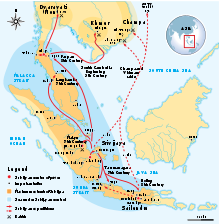The other four toll roads including Kampung Melayu-Kemayoran, Pasar Minggu-Casablanca, Kampung Melayu-Duri Pulo and Ulujami-Tanah Abang will be built in next three phases. The six elevated toll roads will add 67.74 kilometers to the Jakarta’s road length and will cost Rp. 40 million (US$ 4.4 billion). Are these new elevated toll roads going to reduce the traffic congestions in Jakarta? As many critics have said about these new toll roads, the new elevated toll roads will not alleviate the traffic congestions, but will even worsen the chronic transportation problems in Jakarta.
The traffic congestion in Jakarta can't be separated from the high growth rate of vehicle ownership -- 9 to 11 percent per year -- which is not supported by the growth of road development, which is only less than 1 percent per year. The development of new roads will never meet the high growth rate of vehicle ownership. A new highway or a widened road only alleviates traffic congestion for a short period of time. After a few years, any new highway fills with traffic that would not have existed if the highway had not been built. Similarly, any widened road fills with more traffic in just a few months. Such a phenomenon is called induced demand. Because of induced demand, neither building new roads nor widening roads are viable long-term solutions to traffic congestion.
The new toll roads will also undermine the efforts of developing the mass transportation system in Jakarta. The main idea of developing the mass transportation system including busway, monorail, and the Mass Rapid Transit (MRT) projects in reducing the traffic congestion is to reduce the number of car riders and motorcyclists in the Jakarta’s streets. The car riders and motorcyclists are expected to use the mass transportation modes and reduce the burden of the Jakarta’s streets. The new toll road will attract car riders back to the Jakarta’s streets.
Not only will the elevated toll roads cause the induced demand and worsen traffic congestion, but also could jeopardize the livability of neighborhoods along the elevated the toll road. In many cities in other countries, such as Seoul, New Orleans, San Francisco and New York City, the elevated freeways caused the declining livability of neighborhoods along the elevated freeways. In many developed countries, we have seen the shift in urban planning from enhancing mobility toward promoting livability.
The Chonggyecheon freeway was completed in 1977 and was also used as a symbol of modernization and industrialization in South Korea after the Korean War. This elevated freeway was built above 5.8 kilometers creek flowing west to east through downtown Seoul. In 2000, the area was considered as the most crowded and noisy parts in the city of Seoul and became an eyesore of the city of Seoul. In July 2003, then-Seoul mayor, incumbent South Korean President Lee Myung-Bak, launched a project to destroy the Chonggyecheon freeway, revitalize the surrounding area and restore the river flow. During the demolition process of the Chonggyecheon freeway, the Seoul city administration also developed public transportation systems, including Bus Rapid Transit lines. Today, the Chonggyecheon area has been revitalized and become one of the main tourist attraction areas in the city of Seoul.
In 1973, New York City’s West Side elevated highway collapsed and was never repaired but replaced by a surface boulevard of West Avenue. Similarly, two elevated freeways in San Francisco, Embarcadero and Central Freeways, were badly damaged by the Loma Prieta earthquake of 1989. The San Francisco city administration decided not to rebuild the elevated freeways, but replaced them with surface boulevards. The conversion of elevated freeways in both New York City and San Francisco did not cause traffic havocs. The traffic switched to the boulevards, nearby street or mass transit (James and Norquist 2010). Furthermore, a team of researchers from the UC Berkeley (Cervero, Kang, and Shively 2009) found that the conversion of elevated Embarcadero and Central Freeways with boulevard has stimulated reinvestment in the neighborhoods along the freeways without seriously sacrificing transportation performance. More recently, the residents of New Orleans have decided not to rebuild the damaged elevated expressway caused by the Hurricane Katrina, but replace it with an oak-lined boulevard (James and Norquist 2010).
The conversion of elevated freeways to surface boulevards in Seoul, New York City, San Francisco or New Orleans is evidence of a paradigm shift from a focus on expediting the movement of automobile to a focus on increasing the livability of neighborhoods. The livability of neighborhoods should be prioritized over the increase of mobility. Jakarta needs to learn from what has happened in Seoul, New Orleans, San Francisco or New York City regarding the elevated freeways. Not only is the proposed six elevated toll road projects the solution for the traffic congestion in Jakarta, but also they could cause the decline of livability of neighborhoods along the elevated toll roads. The Jakarta city administration should revisit their decision to build the new elevated toll roads and instead they should focus their efforts on building mass transportation systems in alleviating transportation problems in Jakarta.
References:
- Cervero, R., Kang, J., and Shively, K. (2009). From elevated freeways to surface boulevards: neighborhood and housing price impacts in San Francisco. Journal of Urbanism 2(1): 31-50
- James, C. and Norquist, J. (2010). Tearing down an expressway to restore a community. http://www.nola.com/opinions/index.ssf/2010/08/tearing_down_an_expressway_to.html
(This article also appeared at The Jakarta Post on September 4, 2010)
















































